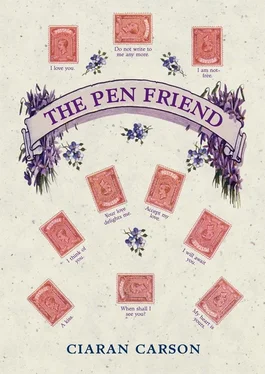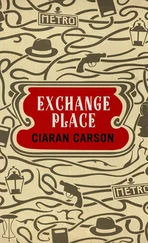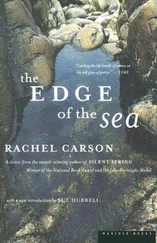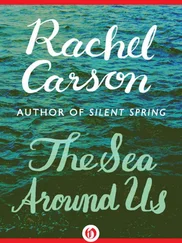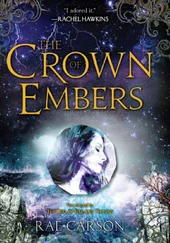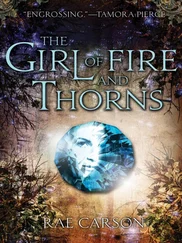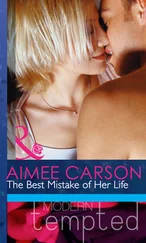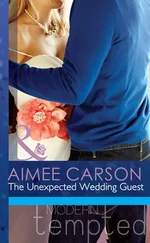Klein’s all-blue paintings were first seen in Milan in 1957, where he exhibited a series of eleven such works. To a casual observer they all looked the same, but Klein assigned different prices to them, claiming that each reflected not what the painting ‘looked like, but the intensity of feeling that had gone into making it’. The blue was a feeling blue. In any case, the pieces were not identical, said Klein; and I am reminded of my father’s observation regarding the blades of grass on the lawn of Botanic Gardens, that every one is different from its neighbour because, despite appearances, nothing in the world is the same as anything else. The blue world of each painting, said Klein, although the same blue and treated in the same way, presents a completely different essence and atmosphere. None resembles any other — no more than pictorial moments resemble each other — although all are of the same superior and subtle nature, marked by the immaterial, said Klein.
Your card is postmarked Nice, where Klein was born in 1928. Blue always evoked to him the Côte d’Azur. When he embarked on his Blue project, he searched for some time before finding a suitable canvas, a cotton sailcloth used for the canopies of Paris street-market traders. He liked its artisan quality, its association with both sky and sea. Every piece was a unique textural field of nubs and bracks and flaws. As he proceeded with the IKB series, the individual panels began to come out differently. Some were utterly flat and thinly painted; many were dry and grainy, or lush and velvety; the surfaces of others were undulating, swirled, grooved, rutted, or embossed. Though every moment in time had its unique quality, all could be absorbed by blue, said Klein.
I knew little about Klein’s work, or the philosophy behind it, when I first saw IKB 79 with you, but I was immediately attracted by its intensity of colour. Only in subsequent, closer viewings did I realise that its surface was not entirely uniform, but had a dimpled, translucent shimmer like that of distemper paint, though I do not know how much this might be due to the passage of time. It reminded us both of the stained glass in York Cathedral, and I was not surprised to discover that Klein had been influenced by the ethereal blue of the stained glass in Chartres Cathedral. Klein espoused a peculiarly mystic brand of Catholicism, immersing himself in Rosicrucianism, and becoming a Knight of the exclusive Order of the Archers of St Sebastian. One of his most sumptuous works is the votive offering he made for the shrine of St Rita of Cascia, a Perspex box containing rose pigment, blue pigment, and gold leaf. Viewed in this light, IKB 79 is a religious icon. Through blue and beyond blue, said Klein, he felt himself grazed by the quivering of the absolute, a tangible representation of celestial space.
Klein had visited Hiroshima in 1953. As he was being shown around the city he remarked on the beautiful, cloudless blue sky, and was told that the atom bomb had dropped out of just such a sky on 6th August, 1945. In that immaculate summer light of 1953, the few relics of the city’s most defining moment — that of its erasure — stood out clearly amidst the ongoing work of reconstruction. The ruined dome of the once beautiful Art Deco Hiroshima Prefecture Industrial Promotion Hall, still left partly standing when everything around it had been levelled to the ground, had been preserved as an admonitory feature, as were the white shadows imprinted on hard surfaces by things and people vaporised by the explosion. Etched into the wood of an electric pole were the bold, serrated leaves of a Fatsia japonica , which reminded Klein of reports he had heard of the patterns burned into the skin of some women, from the shapes of flowers on their kimonos. He learned that in the immediate aftermath of the explosion people supposed they had been the victims of a Molotoffano hanakago — a ‘Molotov flower basket’, the Japanese name for the self-scattering cluster-bomb known to the Americans as a ‘bread-basket’. When the full extent of the devastation began to be realised, a rumour circulated that an aircraft had dusted all of Hiroshima with a special magnesium powder so fine as to be invisible, which exploded like a gigantic photographic flash when ignited by a spark from an overhead power cable. At the Red Cross Hospital, word went around among the staff that there must indeed have been something very peculiar about the bomb, because on the third day the second-in-command had descended to the basement, and, opening the vault where the X-ray plates were stored, found the whole stock exposed as they lay. Only gradually did the truth emerge, and then it was not believed by many.
Klein’s visit to Hiroshima was by the way. He had gone to Japan principally to study judo. He became an expert practitioner of the art, being awarded the fourth dan black-belt on 14th December 1953. He had long been fascinated by how the body cuts a shape in space, leaving behind innumerable, invisible impressions of itself on the air. Although the principle of judo was not one of staccato aggression, but of a seamless flow, Klein recognised that its repertoire of actions could be broken down into a series of pivotal moments. In his book Les Fondements du Judo , published in 1954, he analysed the syntax of judo movements in meticulous detail, accompanying them with hundreds of still photographs derived from film footage taken in Japan: illustrations of the importance of timing, of recognising the split second when the opponent’s equilibrium can be turned to disequilibrium, his apparent greater strength to weakness. Learning to fall, one learned to overthrow. Gradually, through practice and inner visualisation, the most effective attitudes were remembered by the body, so that its responses to attack became second nature.
Klein was deeply affected by Hiroshima. He paid homage to the ghostly presences of its atomic silhouettes in a piece he called Hiroshima . This was one of a series of ‘anthropometries’, made by spraying blue pigment around live models posed on a large sheet of white paper, who, when they removed themselves, left behind a shadowy, retrospective choreography of body-shaped spaces. At the back of Klein’s mind were apparitions of the Virgin Mary; the miraculously preserved bodies of saints, particularly that of St Rita of Cascia; the ‘mummies’ of Pompeii; and the faint impressions left by a person on a judo mat.
As you know, Nina, blue is a favourite colour of mine. You remember that first day I showed you around the Municipal Gallery, when we looked at Gerard Dillon’s Yellow Bungalow . Then, by way of contrast, I showed you, as my father had first shown me, the Gallery’s most prized exhibit, J.M.W. Turner’s Dawn of Christianity , subtitled Flight into Egypt . I had always loved the blue of the sky in this painting, which is inspired by the Gospel story according to St Matthew: ‘And when they were departed, behold, an angel of the Lord appeared in sleep to Joseph, saying, Arise, and take the child and his mother, and fly into Egypt, and be there until I shall tell thee. For it will come to pass that Herod will seek the child to destroy him’ — a text my father would habitually quote to me each time we saw the painting, as I did to you, for it was ingrained in my memory. And I told you that my father would explain to me that Herod was an agent of the Roman Empire, comparing its jurisdiction in the Holy Land to that of the British in Ireland. I saved you the gory details of my father’s account of the Massacre of Innocents that followed, but when I mentioned that the Catholic Church considered the Innocents to be martyrs, you asked if one could be a martyr without full knowledge and complete consent. You’d make a good Jesuit, I said, you know they were trained to be devil’s advocates, to see both sides of an argument. Yes, you said, I know, it’s useful to imagine what it must be like to be somebody else, to see things from another’s point of view. And we gazed into Turner’s opalescent blue sky, below which the fugitive Holy Family were almost indecipherable details in a dream landscape. My father would say that blue signifies a detachment from the things of this world, I said, an inclination of the liberated soul towards God. In other words, it was the colour of flight.
Читать дальше
